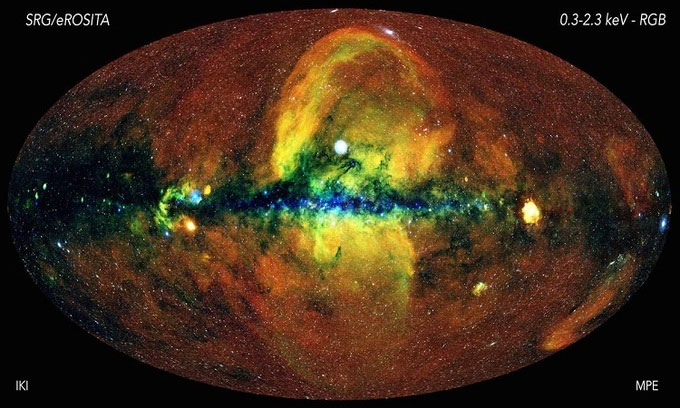Space map contains over a million celestial objects
The X-ray telescope completed the first survey of the entire sky, helping researchers create a detailed map of the universe.

Space map is aggregated from data of telescope eROSITA. (Photo: Phys.org).
The eROSITA X-ray telescope scans the sky for more than 182 days and finds twice as many X-ray sources as the total number known in the last 60 years. This full-sky image reveals the detailed structure of the hot gas in the Milky Way galaxy, hot-rimmed stars and strong magnetic fields, X-ray binary systems, black holes, remnants of supernovae, dwarfs white, neutron stars, Milky Way and other galaxies like the Magellanic Cloud. This map is 4 times deeper than the previous full-sky survey conducted by the ROSAT telescope 30 years ago.
eROSITA was developed by German and Russian astronomers. The device started working last year. According to Peter Predehl, head of the X-ray telescope research institute at the Max Planck Institute (MPE), eROSITA has completed the deepest observation of the sky using X-rays. Researchers consider the universe to be full of energy.
Unlike other telescopes, eROSITA records X-ray emission from space. Clusters of galaxies that look like X-rays spread wide due to the hot gas blocked by dark matter. Featured in the photo is hot gas in the Milky Way and surrounding galactic space. This is the key to understanding the galaxy's formation process. EROSITA's survey also recorded many extremely rare phenomena, such as glare from small celestial bodies, merged neutron stars and black-swallowed stars.
The team collects and processes about 165 gigabytes of data from seven cameras mounted on telescopes. Rashid Sunyaev, a member of the research team, said he and his colleagues are starting a second full-sky survey scheduled to be completed by the end of this year. Over the next 3.5 years, they will make 7 more maps.
- Capture 'ghost' photos in the universe
- Discovering two strange celestial bodies
- The reason why China's 8.5-ton space station doesn't burn out when it falls
- Discover the largest celestial object cluster in the universe
- How many celestial objects are threatening the Earth?
- Special objects have been put into space
- Can objects that fall into Vietnam be 'space bridge'?
- Earth-like celestial bodies may exist aliens
- In 2019 the Chinese space station will fall to Earth
- Photograph of the 8.5 ton Chinese space station about to fall to Earth
- Detecting celestial bodies coming from the Second Solar System in the universe
- Additional discovery of the third 'space sphere' in Vietnam
 Van Allen's belt and evidence that the Apollo 11 mission to the Moon was myth
Van Allen's belt and evidence that the Apollo 11 mission to the Moon was myth The levels of civilization in the universe (Kardashev scale)
The levels of civilization in the universe (Kardashev scale) Today Mars, the sun and the Earth are aligned
Today Mars, the sun and the Earth are aligned The Amazon owner announced a secret plan to build a space base for thousands of people
The Amazon owner announced a secret plan to build a space base for thousands of people